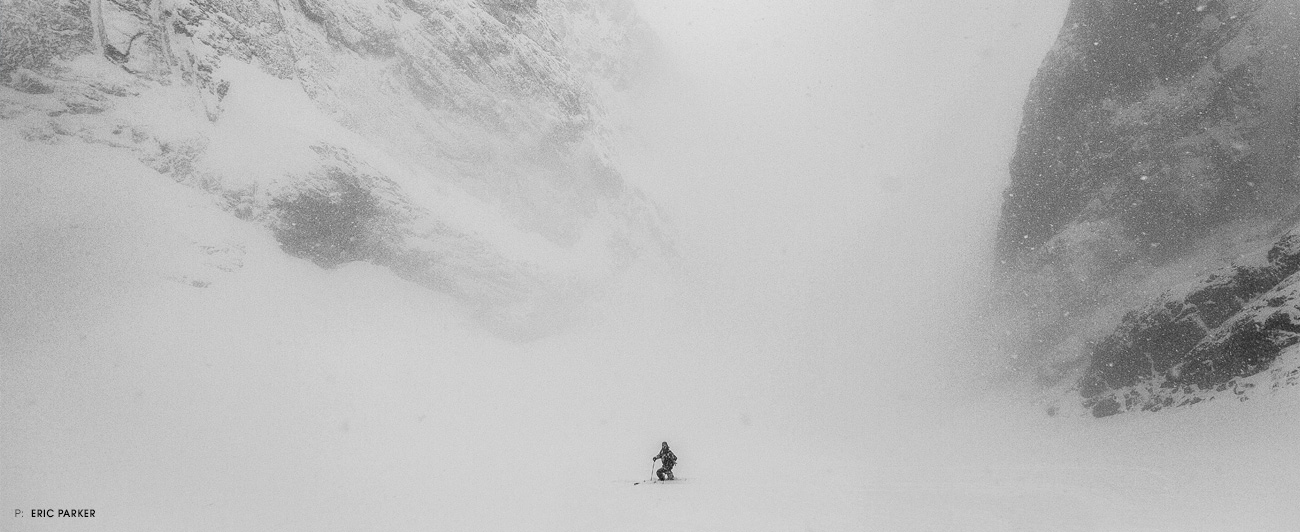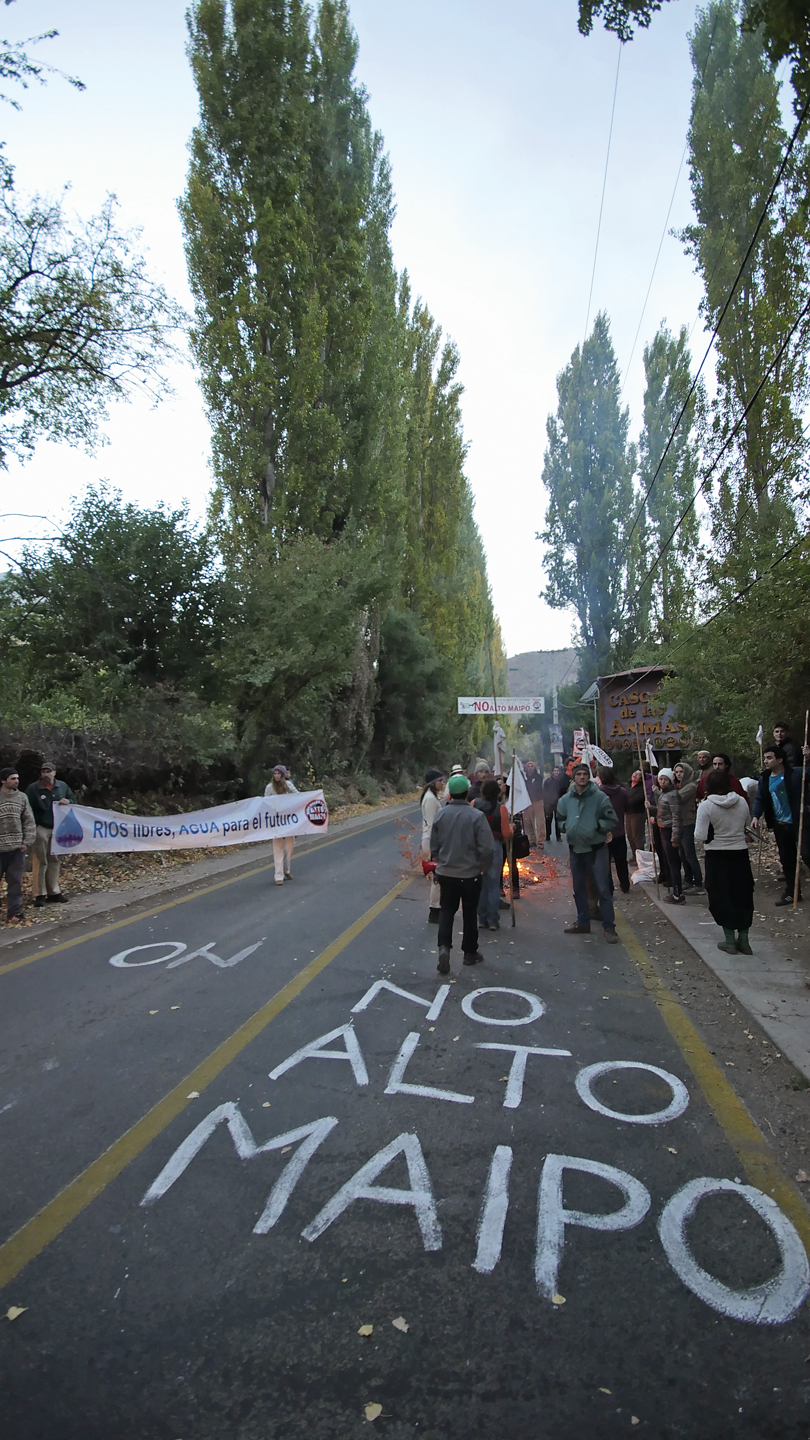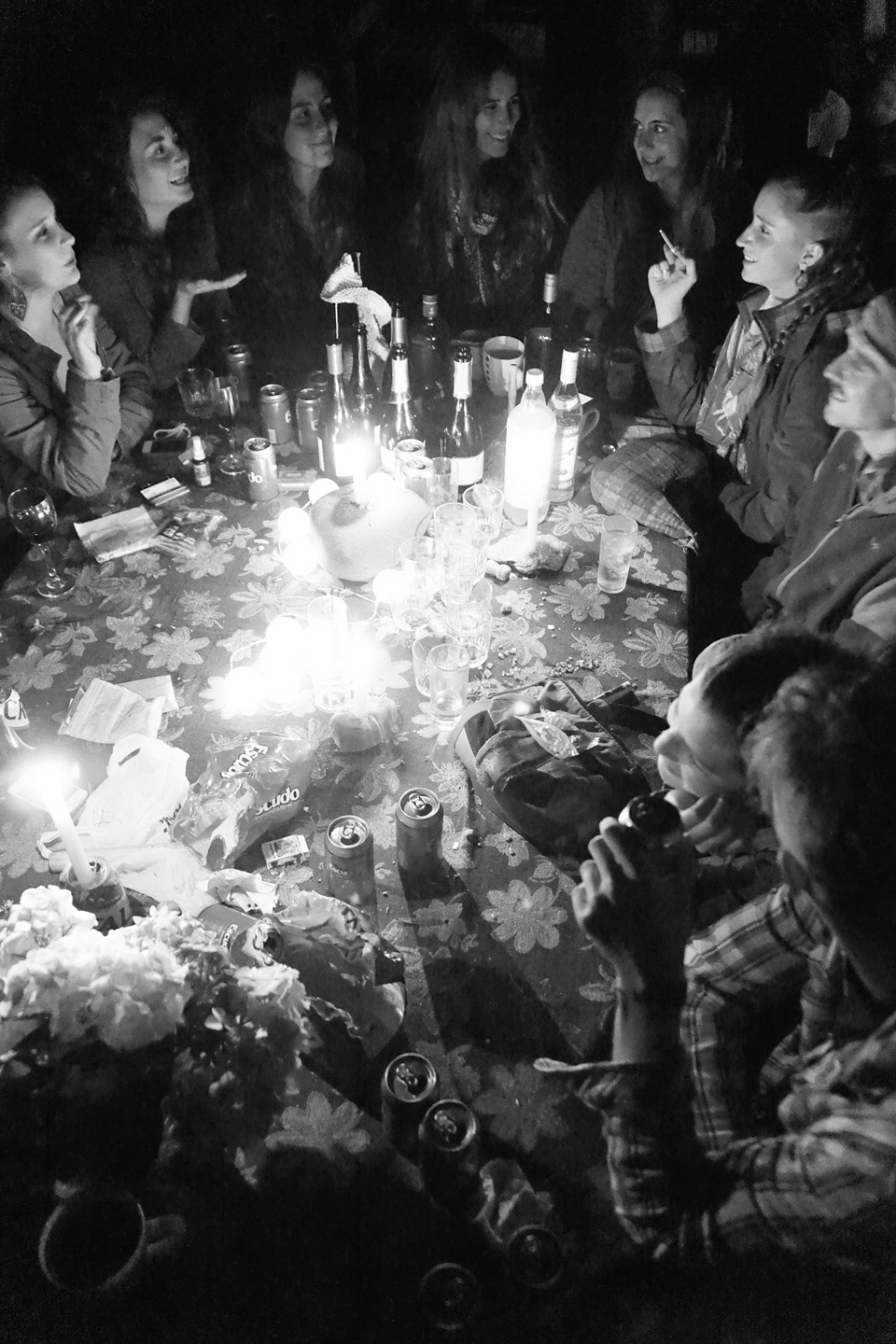Adventure
NO PASA
Couloirs and Controversy in Chile’s Maipo Valley
above The moment before the plunge. Blaine Gallivan enters a massive couloir and thick cloud cover into the Valle de las Arenas. Photo: Eric Parker
The explosions cut through the August fog filling the couloir, echoing off the steep walls and startling us from our bootpacking trance. Visibility is near nothing, and our first guess is an avalanche—one we quickly disregard, knowing the stability of the snowpack. As we stop to discuss the succession of blasts, we realize it is dynamite, ringing from the valley floor. Our thoughts immediately turn to Tino and Lorenzo, our friends and hosts, who are waiting below and who have potentially been illegally filming the blasts. We quicken our pace, and take our final steps
to the top.
The fog clears, and below us the vast expanse of Chile’s Valle de Las Arenas opens up, a high alpine valley ringed by a spider web of couloirs and steep faces—empty, endless potential. The 2,000-foot couloir is the type worth flying thousands of miles, driving dozens of hours, and sneaking past armed guards to ski. All of which we have done.
Then I see the dam. Or rather, the impact of its construction.
Dozens of people work heavy machinery, spread across miles of torn ground. Piles of dirt marked the tunnels the workers were drilling through the mountains to redirect water from the next valley over. The project isn’t new—the cluster of industrial buildings attests to that.
The raw soil, we’ve learned, is part of a decade-long conflict involving Chile’s government, some of the country’s largest mining and power companies, and the Maipo Valley’s small, generations-deep community.
And now, looking at the scene below, we begin to understand what is at stake.
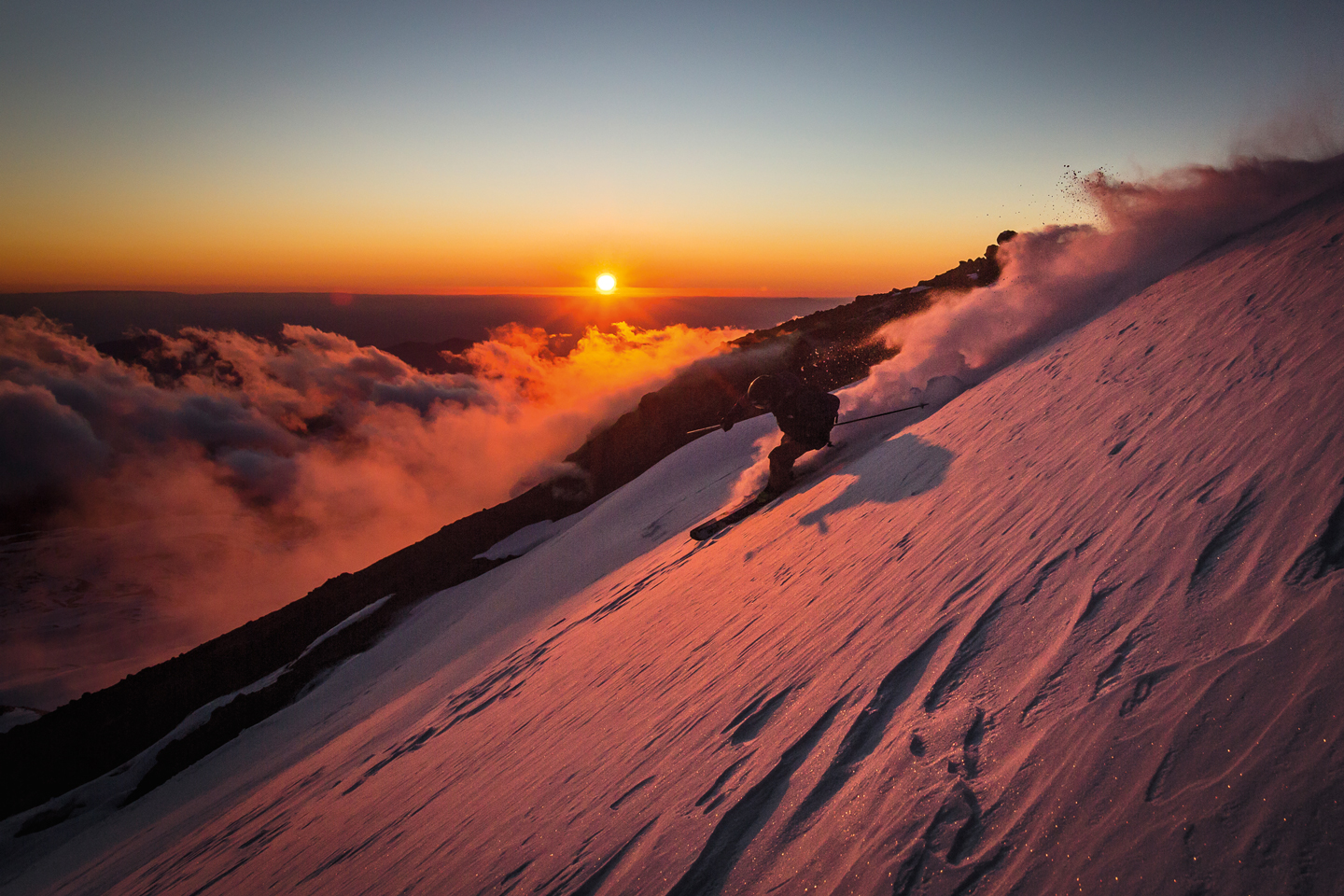
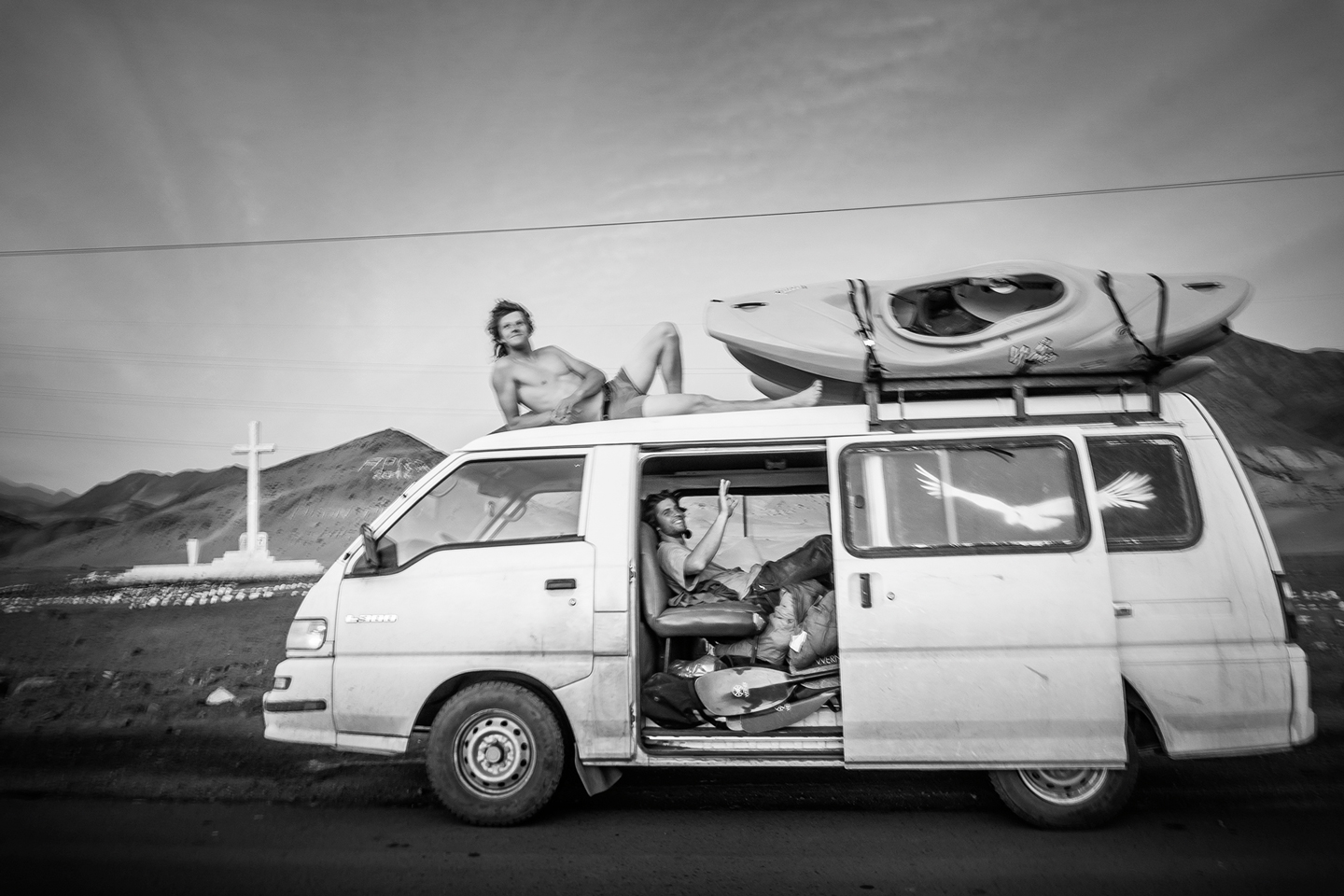
above top• As a window of difficult weather pounded the Maipo Valley, Blaine Gallivan and Eric Parker headed out to some of the more established ski zones in the area, including Nevados De Chillán. Blaine enjoys the last rays of sunlight on the 10,135-foot Volcan Viejo near the resort.
Photo: Eric Parker
above bottom• “Condor Blanco,” as Eric Parker’s van has been dubbed, has long roamed the rivers and valleys of Chile’s mountains—a true adventure wagon.
Photo: Tomas Farren
The journey began a week before, when I arrived in Chile. The sense of tension and unrest started a few hours later, shortly after I checked into my hostel in Santiago.
The plan had been simple enough. It was the idea of Eric Parker, a whitewater kayak photographer whose work stretches from Alaska to Iceland to Peru and beyond. Eric had spent numerous summer months in the mountains and rivers of the Maipo Valley, which is known for some of the best boating in South America. Those same mountains, Eric predicted, also held the potential for incredible, foot-accessed skiing. I bought a plane ticket.
It was 5 a.m. when I was startled awake by a rumble through the hostel wall. I ducked outside, and saw hundreds of people marching down the streets, chanting and carrying signs. And they were pissed.
During the bus ride south to the tourist town of Pucón, Eric’s home base, I learned the protests were mostly students denouncing the expensive, mostly privatized education system, a remnant of Augusto Pinochet’s dictatorship. It wasn’t the only issue on the minds of Chileans. A struggling economy, government corruption scandals and unfulfilled promises by President Michelle Bachelet had people on edge, and I was seeing the raw results.
No frustration greeted me a few hours later—just Eric’s huge grin, his impressive mullet and some bad news. “Well, mate, rats chewed some cables in the van,” he said. “It’s in the shop. And it’s probably going to take a few days.”
I ducked outside and saw hundreds of people marching down the streets, chanting and carrying signs. And they were pissed.
ABOVE•Since it began in 2007, locals have staged protests against the Alto Maipo Hydroelectric Project in an effort to slow construction efforts. While early efforts included burning tires and blocking roads with boulders, more recently the “No Alto Maipo” campaign is bringing together activist groups, attorneys and media teams to bring the issue to the larger world. Photo: Tino Specht
Luckily, Pucón is a good place to waste some time. Located on the slopes of Volcano Villarica, the town is famous for its plentiful rivers, and Eric had a boat for me to borrow. Eventually the van was fixed, and promising forecasts pulled us back to our original mission. We loaded the van and headed north, to the Maipo Valley.
Eric discovered the area via Lorenzo Andrade, a local who runs a production company out of the area. We made our way through the darkening smog of Santiago, rising quickly into the mountains north of the city, and Eric told me about the Maipo’s potential and Lorenzo’s role as an activist in the area. He mentioned a hydroelectric conflict, but I was too distracted. Silhouetted against the stars, the peaks ahead looked massive.
Slowly, the pavement turned into dirt, and soon we entered the small mining town of Baños Morales. A line of cones blocked the road, alongside a small security shack. Two men stepped out of the dimly lit building, wearing traffic vests and hard hats, and surrounded our vehicle. Despite the language barrier, I picked out the emphatic “No pasa” with which they answered nearly all of Eric’s questions. It was the start of a private construction zone, Eric translated, and there was no way we could enter. Instead, Eric and I made the executive decision that “No pasa” really meant “Try harder.” That’s the beauty of having a camper van. We could wait.
At 4:30 a.m., we cut below the dirt road and slid past the guard shack in the darkness. The closure added numerous miles to the approach, but as the sun rose, we quickly forgot the slog. Peaks and ridges extended in every direction, with long ramps slicing through stone walls and huge glaciers turning pink in the morning light.
The morning, however, also revealed less savory aspects of the valley. We skinned past bulldozers, huge holes and piles of torn-up dirt and debris. It stank of oil and exhaust, and we noticed the terrain wasn’t just broken with a gallery of thin couloirs. A vast network of dirt roads snaked behind us, connecting the orange mine tailings with a hub of buildings.
We picked a promising couloir from the lineup, but were stopped halfway by an approaching storm. Instead, we jumped on the first window to ski down, hugging the rocky wall, slashing and spraying the stone with every turn.
Then the dynamite came, and we took in the sobering view of the hydro project and nearby mines. Lorenzo’s passion the night before had been surprising. Now we understood why.
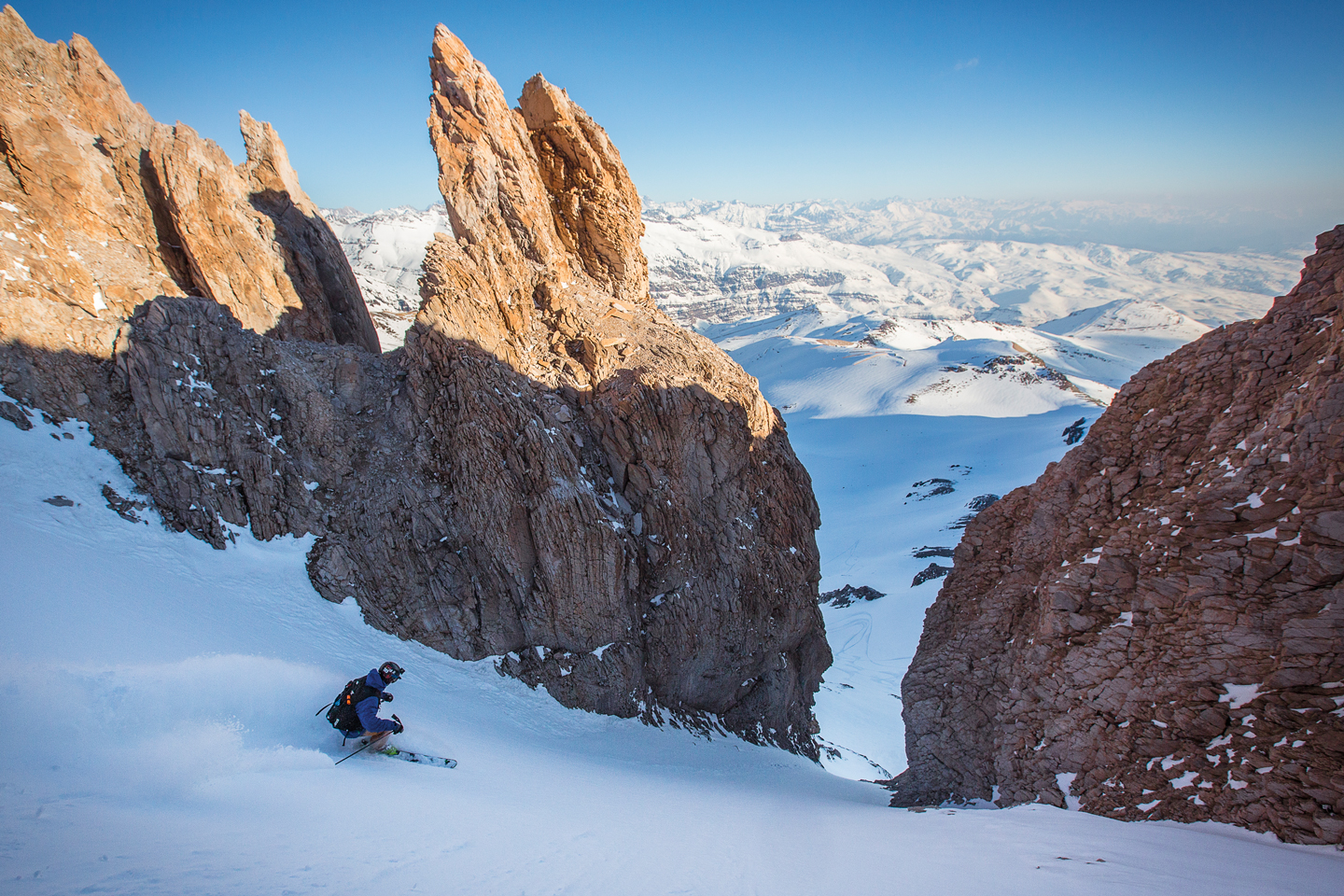
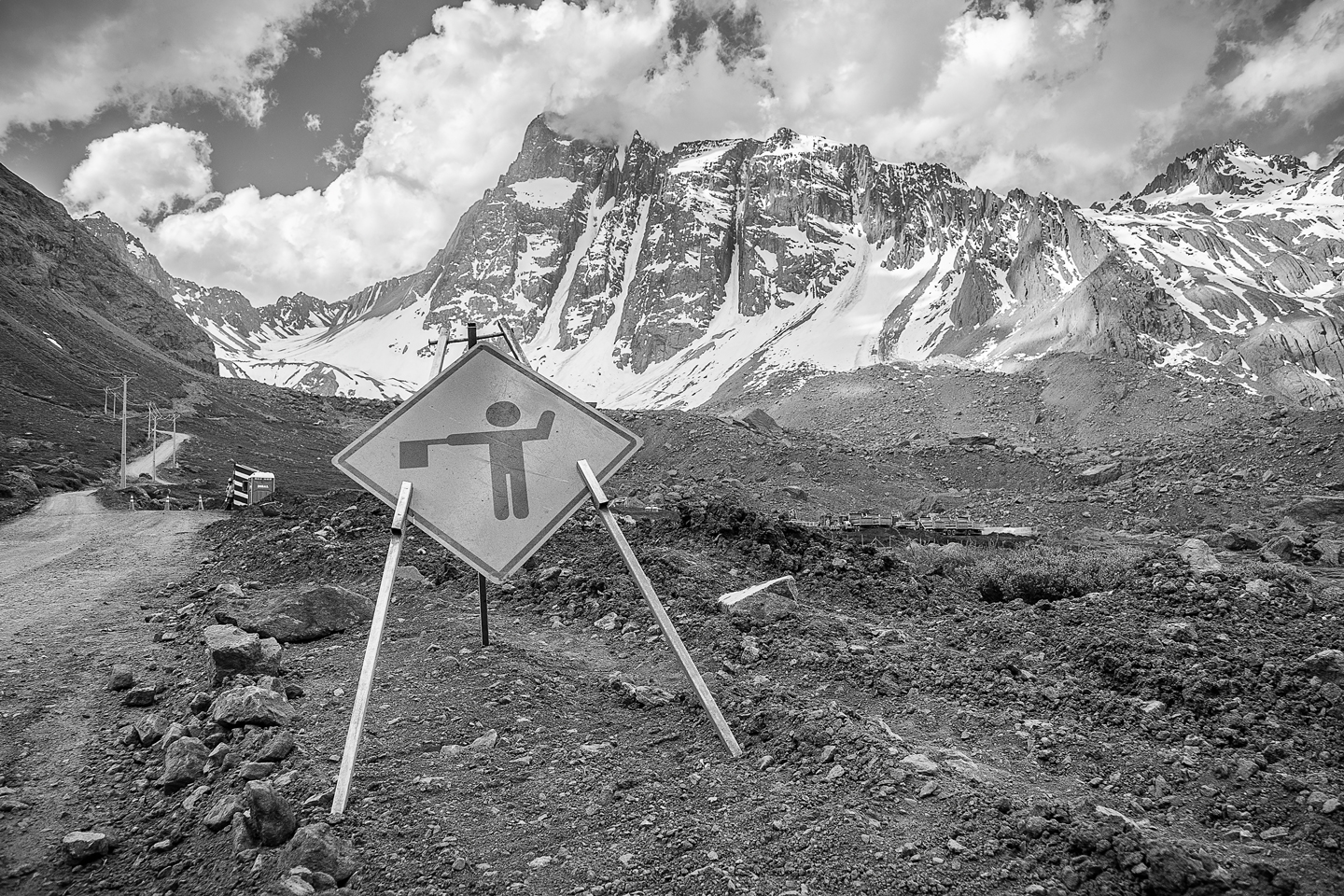
ABOVE TOP•Valle Nevado is one of Chile’s premier ski locales, partly due to the area’s exceptional backcountry, but mostly due to its location in the impressive Cordillera Central mountains near the capital city of Santiago. Blaine sizes up a couloir just outside of the resort before dropping in.
Photo: Eric Parker
ABOVE BOTTOM “No pasa” really means “Try harder.” Three giant couloirs loom in the distance, while closer up is a guard station blocking the road. Photo: Eric Parker
That night was the first time I met Lorenzo and his friend and business partner Tino Specht, over a traditional asado cooking pit. We were still damp from skiing, and the brothers and their friends were still soaked from paddling a stretch of the Maipo River. The two own Nomade Media, a production company based in the small town of San Alfonso. They specialize in action sports, but work on everything from weddings to documentaries. Beyond being heavily involved in the valley’s outdoor community, Lorenzo’s family is well known for their environmental activism. Lorenzo eagerly fills me in on the mining operation we passed and the hydro project that has divided the area for more than a decade. “These people,” he said, “they are fucking stealing our water!”
In 2007, he explained, Alto Maipo Hydroelectric Project—run by the mining corporations Aes Gener and Antofogasta Minerals—began construction on a 44-mile tunnel. The project, now in its 10th year, cuts under the entire mountain range to divert freshwater from the Volcan, Yeso and Colorado rivers to a hydropower plant located in Santiago.
Originally, the concept was publicized and promoted as a source of electricity for the 5.1 million citizens of rapidly growing Santiago. But when the project starts generating power, 80 percent will be used by Antofagasta Minerals for mining and the rest will be sold to Argentina, leaving none for Chile. The project is just the newest manifestation of policies that began with Pinochet in the 1970s and ’80s, when he began selling off natural resources to international companies. Chile is the only country in the world that doesn’t own its own water.
Now 14 percent complete, the project threatens to dry up entire rivers, forcing families from ancestral homes, cutting off water to some communities, and causing havoc for the tourism-based towns and surrounding ecosystems. But over the past five years, thanks to the efforts of people in the area, protests have started to gain traction on a national scale.
By the time Lorenzo finished speaking, the chorizo was all but scraps and the bottles of pisco were empty. We basked in the heat of the fire, drying our damp ski gear, and moved on to lighter subjects, like the local skiing.
The next morning, we once again drove toward Valle De Las Arenas and the guard station, this time with Lorenzo and Tino. We hoped to tick off at least a few of the couloirs; Lorenzo and Tino hoped to film it. The truck bounced along the dirt road, sagging with camera and ski gear. Lorenzo reassured us he could talk his way through the roadblock, but to our surprise there were no guards.
The valley’s three largest couloirs came into view, and we strapped our skis to our packs and started skinning. It was much farther than we’d expected, and thousands of feet and hours later, Lorenzo informed us via radio that we were too far away to film.
Then the dynamite came, and we saw the torn ground, ragged roadbeds and growling machines about which Lorenzo had warned us.
above •Chileans love to gather and socialize. Good parties will often start at 2 a.m. and last past sunrise, include prodigious amounts of food and—in the case of Lorenzo and Tino and the Andrade family—some spicy conversation.
Photo: Tino Specht
Back on the valley floor, we meet up with Tino and Lorenzo and decide to call it a day. The duo drops us off in San Alfonso, before continuing down the road along the Rio de Yeso for one of their other passion projects: Collecting evidence of river dumping and water contamination by the mining and power companies, a few photos or a 30-second drone clip providing evidence of the destruction happening near their homes.
Later that night, Lorenzo invites us to his family’s house for cazuela, a traditional Chilean chicken stew. The Andrade family’s dwelling sits on a mountain perch, and is only accessible via a wire drawbridge over the Maipo River followed by a half-hour walk up a hiking trail. A grape orchard and dozens of apple, pear and plum trees fill their front yard. It blends into the hillside almost symbiotically, as if it’s always been there—and in a human sense it has, as the family has lived there for multiple generations and has established the property as an animal sanctuary.
Over stew, we listen as aunts, uncles, grandparents and cousins share stories of their past in the valley and worries for their future, as the hydropower project would divert the river running through their front yard. They have watched the gradual degradation brought on by the dams, tunnels and mines. Without the Maipo River, their crops wouldn’t survive, and they would experience a huge decrease in business at their nearby lodge and sanctuary.
His father proudly reminisces about a time eight or nine years before, when their entire community pushed massive boulders into the road and set up roadblocks by burning walls of tires. By shutting down the road, they cost the project millions of dollars per day. Things have changed since. Due to threats from government officials and fear of unnecessary violence, they’ve started the No Alto Maipo campaign, which has pulled together activist groups, attorneys and media teams to bring greater awareness to the issue.
Unfortunately, the next day the weather turns sour—actually, it starts storming so heavily we can’t ski—and we depart for Nevados de Chillan, where we spend a week skiing volcanos and celebrating the National Day of Independence, Diez y Ocho, with locals in the area.
During our previous conversation about the hydro project, Lorenzo’s cousin Canela—an avid skier, climber and mountain guide—told us of incredible mountains surrounding the Yeso River Valley and Embalse del Yeso, a massive reservoir 30 miles from Valle de Las Arenas. As one of the rivers diverted by the tunnel and the same one Lorenzo and Tino were filming before, our curiosity gets the best of us, and we turn our mission in that direction.
Arriving at the end of the Yeso, the reservoir is a stunning, split horizon of dark blue water and craggy, white mountains, similar to Portillo’s Inca Lagoon. Armed with three of Lorenzo’s river kayaks and a heap of chorizo, bread, cheese, avocados, chocolate, dried fruits, firewood and pisco, we set out for the far shore. One kayak is packed with gear and food, guaranteeing that an already inefficient craft will be even more cumbersome, but more weight equals more luxury.
The next morning we ramble up the steep canyon and drag out the heavy kayaks, cursing our previous gluttony until we arrive at the shore. The sluggish gear bobs behind us, but our eyes are fixed on the peaks ahead. With each stroke, cold water soaks our gloves and runs down our jackets.
On the far shore we strap the kayaks to our waists to break trail to a big rock wall to a sheltered campsite. It’s just a few hundred feet, but it’s already lunchtime by the time we get settled and head out on a scouting mission.
The wall of potential lines above us looks even more promising, and after heavy pondering we decide on an objective. But when we look back, the view is again marred by another project zone: large dam lays at the far end of the reservoir, turning the once-thunderous Yeso River into a faint trickle. Lorenzo hadn’t been exaggerating.
It takes only a bit of sunlight on our tent to wake us. We pull on our rock-hard boots, letting oatmeal and coffee simmer while the plastic slowly warms up. Four hours later, we arrive at the base of the couloir, huge flakes begin to fall, and a curtain of snow closes out the sun and any view up or down. We’re a long way from camp, and considering the lack of definition—there are no trees in the valley—getting lost during the return is a real possibility.
“It’s damn good to be up here with you, brother,” Eric says. We’re not quite at the top, but we both know it’s time to get out of here.
We click into our skis in thigh-deep snow, utterly exhausted and sticking close together for safety, linking dreamy turns into the blank white. The deep blue behemoth of Embalse del Yeso bursts from the clouds, and we lay out huge turns toward the reservoir. At the bottom, Eric breaks out some pisco. It was worth its weight, and it fuels the slog back to camp before we load up and paddle back to the van under a full moon.
The reservoir is a stunning, split horizon of dark blue water and craggy, white mountains, similar to Portillo’s Inca Lagoon.
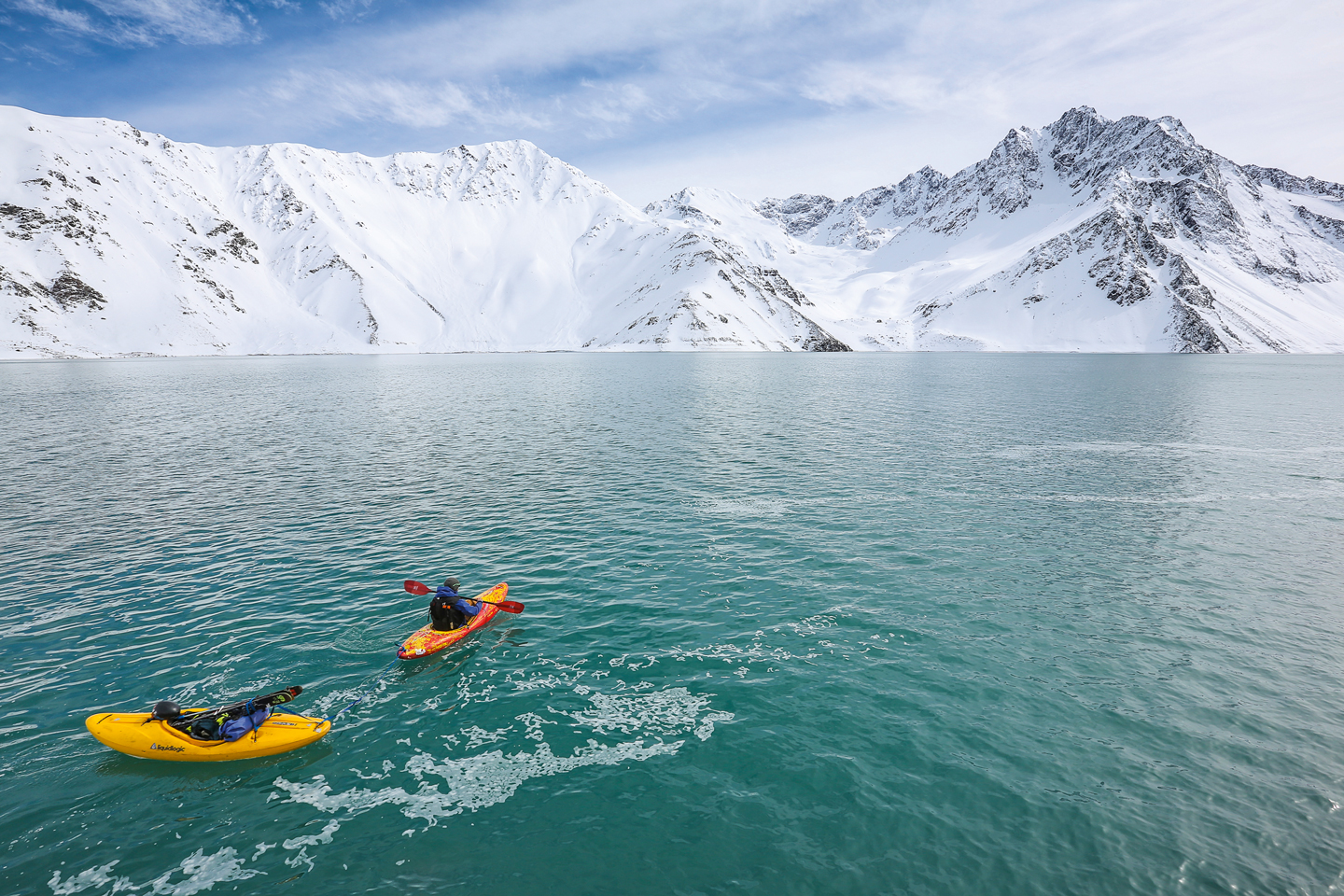
above • At 17,345 feet, Cerro Mesón Alto is one of the more prominent peaks in the area around the Maipo Valley. It also provides one hell of a backdrop for a mid-lake paddle while crossing the Yeso reservoir, gear boat in tow and heading to camp on the opposite shore. Photo: Eric Parker
Back at the Antrade house, I spend my last night sharing wine and empenadas with Lorenzo and his kin. I ask more questions about their campaign and the future of the valley. They’re hopeful. The No Alto Maipo campaign is gaining recognition through rallies and social media, they say, and with the increased publicity and exposure, they feel it is only a matter of time before the corporations slip up and do something obviously illegal for the world to see.
Until then, Lorenzo, Tino and the Andrades are dedicated to bringing as many skiers, paddlers, hikers, climbers and fisherman as possible into the valley. The more people who see the Maipo and hear those dynamite blasts, they figure, the more people they can rally to their cause, and maybe save this incredible place they call home.
This story originally appeared in The Ski Journal Volume 10 Issue 1.
